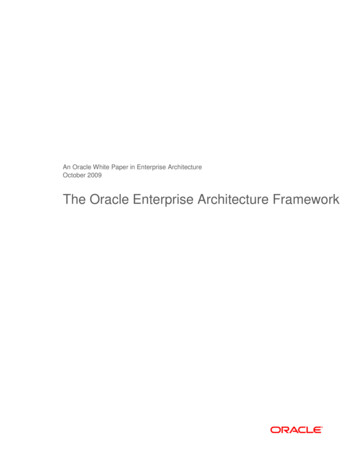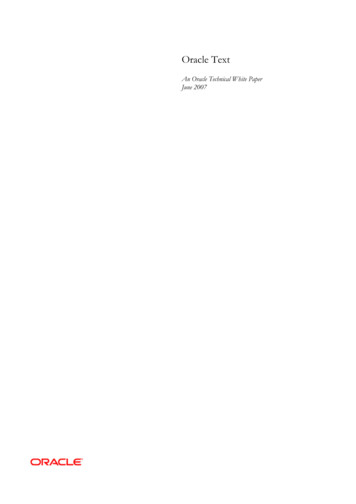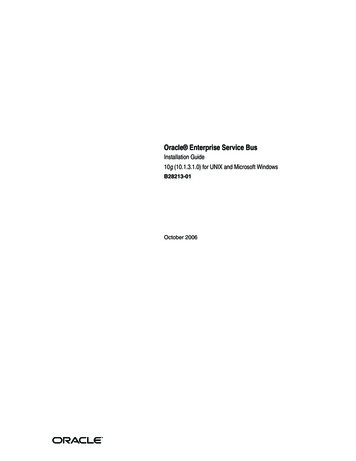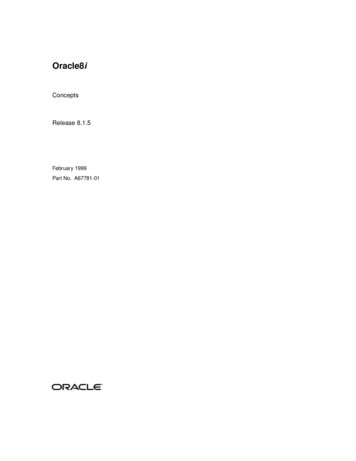
Transcription
An Oracle White Paper in Enterprise ArchitectureOctober 2009The Oracle Enterprise Architecture Framework
Oracle White Paper in Enterprise Architecture—The Oracle Enterprise Architecture FrameworkDisclaimerThe following is intended for information purposes only, and may not be incorporated into any contract. It isnot a commitment to deliver any material, code, or functionality, and should not be relied upon in makingpurchasing decisions.
Oracle White Paper in Enterprise Architecture—The Oracle Enterprise Architecture FrameworkExecutive Overview .1Introduction .1Enterprise Architecture .2Enterprise Architecture Frameworks.3The Oracle Enterprise Architecture Framework .4The Oracle Architecture Development Process .9Summary: Value & Benefits.10A Case Study .11Conclusion .12
Oracle White Paper in Enterprise Architecture—The Oracle Enterprise Architecture FrameworkExecutive OverviewThe Oracle Enterprise Architecture Framework helps Oracle to collaboratively work withcustomers in developing strategic roadmaps and architecture solutions that enablebusiness and IT alignment. Oracle emphasizes a “just enough” and “just in time” practicalapproach to Enterprise Architecture, which may be used standalone or as a complementa customer’s selected EA methodology. By focusing on business results and leveragingOracle’s unique EA assets and reference architectures, the Oracle EnterpriseArchitecture Framework can be employed to efficiently create architecture roadmaps forimplementing business-driven enterprise solutions.IntroductionIn the early days of computing, technology simply automated manual processes withgreater efficiency. As technology evolved, new innovations enabled new capabilities andprocesses in the enterprise that were driven by IT. Gradually, IT changed the businessbut not necessarily in alignment with the business strategy. This lack of alignmentresulted in significant waste of resources and missed opportunities, and placed theorganization in a competitive disadvantage in the market.To align the strategies of business with IT, a new approach for managing IT has beendeveloped called Enterprise Architecture. Just as architecture provides a blueprint forconstructing a building, Enterprise Architecture provides a blueprint and roadmap foraligning business strategy with IT“The real value of Enterprise Architecture is not in making better architectures it’s in making better enterprise.”Gary Doucet, Chief Architect,Government of Canada Treasury Board of Canada Secretariat GC1
Oracle White Paper in Enterprise Architecture—The Oracle Enterprise Architecture FrameworkEnterprise ArchitectureEnterprise Architecture (EA) is a method and an organizing principle that aligns functionalbusiness objectives and strategies with an IT strategy and execution plan. The EnterpriseArchitecture provides a guide to direct the evolution and transformation of enterprises withtechnology. This in turn makes IT a more strategic asset for successfully implementing a modernbusiness strategy.An Enterprise Architecture typically produces deliverables such as: Current State Enterprise Architecture model Future State Enterprise Architecture reference model that is needed to execute on theproposed business strategy Gap analysis that identifies the shortfalls of the current state in terms of its ability to supportthe objectives and strategies of the business Architecture Roadmap that defines the initiatives required to migrate from the current stateinto the future state.By taking an enterprise-wide perspective across business services, business processes,information, applications, and technology, an EA ensures the enterprise goals and objectives areaddressed in a holistic way across all IT projects.To be successful, an Enterprise Architecture needs to be woven into the enterprise’s culture, nottreated as a closed-scope project. The value of an EA is greatly enhanced when it is organicallyembedded into the lifecycle of the organization, including capital planning, project management,asset management, resource allocation, and strategy formulation.Enterprise Architecture is a journey, not a project. It evolves over time and needs to maintain theflexibility required to adjust to changing market conditions, strategy shifts, and new innovationsin technology. EA frameworks have emerged to manage the increasingly complexity ofinnovation and change.Enterprise Architecture is as much about ongoing communications among business and ITleadership as it is about technology innovations and architectural choices. EnterpriseArchitecture facilitates business and IT communication with common language, process, andstructure.2
Oracle White Paper in Enterprise Architecture—The Oracle Enterprise Architecture FrameworkEnterprise Architecture FrameworksCreating an Enterprise Architecture from scratch can be a daunting task, so EA frameworks werecreated to simplify the process and guide an architect through all areas of architecturedevelopment. An Enterprise Architecture framework provides a collection of best practices,standards, tools, processes, and templates to assist in the creation of the Enterprise Architectureand architectures of various scopes.Enterprise Architecture frameworks typically include: Common vocabulary, models, and taxonomy Processes, principles, strategies and tools Reference architectures and models Prescriptive guidance (EA processes, architecture content,implementation roadmap, governance) Catalog of architecture deliverables and artifacts Enterprise Architecture Content Metamodel Recommended set of products and configurations (optional)Utilizing an Enterprise Architecture framework streamlines the process for creating andmaintaining architectures at all levels (e.g. enterprise architectures, functional business segmentarchitectures, cross-cutting technology domain architectures, and solution architectures) andenables an organization to leverage the value of architecture best practices.A number of EA frameworks exist in the industry with the goal of addressing the basic challengeof assessing, aligning, and organizing business objectives with technical requirements andstrategies. Examples include the Zachman Enterprise Framework, The Open GroupArchitecture Framework (TOGAF), OMB Federal Enterprise Architecture (FEA), and TheGartner Methodology (formerly the Meta Framework).Each framework possesses different strengths and weaknesses, which makes it difficult to findany one existing framework that is ideal for all situations. The following chart depicts how fourEnterprise Architecture Frameworks compare.3
Oracle White Paper in Enterprise Architecture—The Oracle Enterprise Architecture FrameworkFigure 1. Industry Frameworks.The Oracle Enterprise Architecture FrameworkIn an effort to provide an efficient, business-driven framework to help our customers align theirIT and business strategies, Oracle created a hybrid EA framework, influenced by TOGAF, FEAand Gartner. This simple yet practical and prescriptive framework is called the Oracle EnterpriseArchitecture Framework (OEAF). The OEAF is complementary to other EA frameworks, withclear mappings to TOGAF and FEA, such that customers can use the EA framework of theirchoice. The intent of building the OEAF was to leverage the strengths of the different industryframeworks and marry that with Oracle’s experience in developing enterprise solutions.The central theme of the Oracle Enterprise Application Framework is to provide “just enough”structure, which can be created “just in time” to meet the business requirements of theorganization. In addition, the OEAF provides a well-known architectural structure for sharingOracle’s vast intellectual capital around enterprise IT solutions with its customers and partners,thereby, further enhancing Oracle’s strategic business value proposition.The Oracle Enterprise Application Framework encompasses nine key values. Driven by business strategy Standardizes and simplifies the technical architecture Comprises “just enough” modeling for enterprise solution architecture efforts Reuses best practice business models and reference architectures from industryand commercial vendors Focuses initially on speed of delivery for high level guidance4
Oracle White Paper in Enterprise Architecture—The Oracle Enterprise Architecture Framework Developed collaboratively with business owners, stakeholders, and skilled architects Developed iteratively and matures evolutionarily for breadth and depth Can be enforced Technology agnostic but leverages Oracle expertise and IPThese principles provide the foundation for agile enterprise architecture capabilities in mappingbusiness requirements to IT implementation.Our best-of-breed approach overcomes many of the complexities and unnecessary rigidstructures associated with other frameworks. The OEAF is designed to provide quick,incremental results. Each process and artifact has been carefully analyzed to reduce waste andprovide the appropriate level of detail required to meet the objectives of the business. TheOEAF avoids time consuming waterfall processes and allows multiple components to bedeveloped in parallel.To further increase the value of OEAF, Oracle also tailors prebuilt reference architectures thatdefine future state architectures. These proven reference architectures drill down from logicalcomponents (for example, functional capabilities) to physical components (for example, Oracletechnologies and products) that complement a customer’s existing environment and can be usedto minimize implementation risks.Components of the Oracle Enterprise Architecture FrameworkThe Oracle Enterprise Architecture Framework consists of seven core components.Figure 2. Oracle Enterprise Architecture Framework Components5
Oracle White Paper in Enterprise Architecture—The Oracle Enterprise Architecture FrameworkBusiness ArchitectureAny architectural discussion should begin with Business Architecture. The Business Architecturealigns an organization’s operating model, strategies, and objectives with IT; it also creates abusiness case for IT transformations and provides a business-centric view of the enterprise froma functional perspective.This part of the framework provides the following three key areas of information about thebusiness: Business Strategy: Key business requirements, objectives, strategies, key performanceindicators, business risks, and the business-operating model (how processes and systemsare centralized versus decentralized across the business). Business Function: The key business services, processes, and capabilities that will beaffected by the enterprise architecture effort. Business Organization: The high-level nature of the organizational structures, business roles(internal audiences, external customers and partners), the decision-making process, and theorganizational budget information.Application ArchitectureThe Application Architecture provides an application- and services-centric view of anorganization that ties business functions and services to application processes and servicesto application components in alignment with the application strategy. The ApplicationArchitecture’s scope, strategy, standards are a consequence of the Business Architecture.The Application Architecture is composed of the following content categories: Application Strategy: The key application architecture principles (Build versus Buy, Hostedversus In-House, Open Standards versus .NET, etc.), application governance and portfoliomanagement, and a set of reference application architectures relevant to the customer. Application Services: An inventory of the key application services exposed to internal andexternal audiences that support the business services. Application Processes: A series of application-specific processes that support the businessprocesses in the Business Architecture. Logical Components: An inventory of the relevant product-agnostic enterprise applicationsystems that is relevant to the stated business objectives. Physical Components: The actual products that support the logical application componentsand their relationships to the relevant components and services in the information andtechnology architectures.6
Oracle White Paper in Enterprise Architecture—The Oracle Enterprise Architecture FrameworkInformation ArchitectureThe Information Architecture describes all of the moving pieces and parts for managinginformation across the enterprise, and the sharing of that information to the right people atthe right time to realize the business objectives stated in the business architecture.The key components for describing the information architecture are: Information Strategy: The information architecture principles, information governanceand compliance requirements, canonicaldata models, and industry data model support strategy and a set of reference informationexchange as well as dissemination patterns and reference models. Information Assets: A catalog of critical business data types and models (such as customerprofile, purchase order, product data, supply chain, etc.) and the relationships between thosebusiness data types and all the services and processes that interact with that data.The Information Architecture provides an information- and data-centric view of an organization,focusing on key information assets that are used to support critical business functions.Technology ArchitectureThe Technology Architecture describes how the infrastructure underlying the business,application, and information architectures is organized. The key components are: Technology Strategy: The technology architecture principles, technology asset governanceand portfolio management strategy, and technology standards, patterns, and referencearchitectures used for developing specific technology solutions. Technology Services: An inventory of the specific technology services and theirrelationships and the business services, application services, information assets andlogical or physical technology components that realize those services. Logical Components: The product-agnostic components that exist at the technologyinfrastructure tier to support each technology service. Physical Components: The set of technology products that exists behind each of thelogical technology components to implement the technology service.The Technology Architecture provides a technical reference model, as documented in Oracle’sEnterprise Software Framework (ESF), that is used to align technology purchases, infrastructure,and solution implementations with the enterprise IT strategies, architecture principles, standards,reference architectures, and governance model.7
Oracle White Paper in Enterprise Architecture—The Oracle Enterprise Architecture FrameworkPeople, Process, and ToolsThis area of the framework identifies the people, processes, and tools used to define enterprisearchitectures and architecture solutions. People: Teams and individuals who are chartered with enterprise architecture responsibilitiesfrom several perspectives–architecture development, maintenance, implementation,and governance. Process: A selection and adherence to a set of architectural processes that are tailored toguide an architecture engagement through a path that maximizes the chance of a successfulimplementation and minimizing resource expenditure. The next section describes severalapplied processes offered by the OEAF. Tools: A set of tools and technologies that accelerate the process of developing and managingenterprise architecture. Most of these tools fall under the category of modeling (for example,ARIS IT Architect, Oracle BPA Suite), portfolio management (for example, Oracle Primavera),and architecture asset repositories (for example, Oracle Enterprise Repository).Enterprise Architecture GovernanceEnterprise Architecture governance provides the structure and processes for implementing anorganization’s businesses strategy and objectives through an Enterprise Architecture. An EAgovernance body is used to guide each project and ensure its alignment with the EA during ITtransformations and solution implementations. Successful EA governance includes: People: Teams, individuals, roles, and responsibilities of the governance board(s) Processes and Policies: Architecture lifecycle management, change management,review cycles, etc. Technology: Infrastructure for implementing the processes and policies of enterprisearchitecture governance Financial: IT cost allocation, project-funding models, business case tools to continuouslymonitor a positive return on investment, etc.EA RepositoryThe EA Repository is an Oracle internal repository for all the architecture artifacts anddeliverables that are captured and developed throughout the lifecycle of an EnterpriseArchitecture. The purpose of this repository is to provide information describing the currentstate architecture and a library of reference architectures, models, and principles that describesthe target desired state of the architecture, given the business objectives. This includes Oracle EAintellectual property for jumpstarting customer EA initiatives and architecting enterprisesolutions.8
Oracle White Paper in Enterprise Architecture—The Oracle Enterprise Architecture FrameworkThe Oracle Architecture Development ProcessTo create these Enterprise Architecture components, Oracle has created a streamlined process tofacilitate their development. The Oracle Architecture Development Process (OADP) defines apractical approach for working with customers collaboratively to align their enterprise andsolution architectures to their business strategies and goals.Figure 3. Oracle Architecture Development ProcessThe OADP provides a generic, base process for developing architectures as part of the OracleEnterprise Architecture Framework. The OADP contains the following components: Six High-level Phases: Architecture Vision, Current State Architecture, Future StateArchitecture, Strategic Roadmap, EA Governance, and Business Case. Oracle’s approachenables many of these phases to be run concurrently to reduce the time associated withcreating architectures of various scopes. Also, the OADP is meant to be a highly iterativeprocess because architectures are developed and refined with feedback. Tasks: Performed in each phase and any prescriptive guidance for performing the task ina practical and most efficient manner that leverages Oracle's EA Repository (of reusablearchitecture artifacts). Deliverables Created in Each Phase: Generally one consumable PowerPoint documentthat summarizes the results of each task and references all artifacts produced in each phase.9
Oracle White Paper in Enterprise Architecture—The Oracle Enterprise Architecture Framework Artifacts Created in Each Phase: Individual models and diagrams; the simplifieddocumentation approach provides just enough detail without requiring excessive overheadassociated with documentation.From the base OADP process, Oracle creates tailored OADP processes that target a specificsegment, domain, and/or solution architecture such as Application Portfolio Rationalization andIT Optimization. These tailored OADP processes use the basic structure and phases of the baseOADP process; however, they are further streamlined by emphasizing the critical path for agiven architecture engagement, and by providing prescriptive guidance, case studies, sampleartifacts, applicable reference models, etc. for executing these critical tasks and creating keyartifacts.Summary: Value & BenefitsThe Oracle Enterprise Application Framework provides significant value to anorganization, including: Continuous alignment of business and IT Improved Return on Investment (ROI) through better execution of the business strategyusing IT, and more efficient reuse of IT resources Leveraging technology to create new business strategies Using a single framework to combine products, services, and architectures aroundall technologyAs an architect, the OEAF provides a number of key benefits. The framework’s practical approach allows the architects to focus on the architecture andnot be bogged down with excessive processes and artifacts, or creating their own processes. The agile nature of the OEAF enables continuous improvements to adapt to changingbusiness conditions and new technologies. The OEAF uses industry EA concepts and terminology and leverages the best of otherframeworks. Access to a set of best practices, tool sets, reference architectures, and tailored architectureprocesses around specific problems (applications rationalization, IT optimization, and more.)will significantly reduce the time required to develop enterprise-level architectures.10
Oracle White Paper in Enterprise Architecture—The Oracle Enterprise Architecture FrameworkA Case StudyA large medical device provider in the United States recently used the Oracle EnterpriseArchitecture Framework to successfully create an Enterprise Architecture to facilitate theiraggressive business strategy. The customer was looking to perform a major overhaul of itsEnterprise Architecture that was driven by two major business objectives: (1) develop a highlyaggressive, 10-year plan to grow revenue ten-fold; and (2) eliminate all major processinefficiencies in its business to increase margins year over year. The customer employs over 1,700employees and enjoys nearly US 500 million annual sales. This level of change and growth wouldrequire a well thought out strategy and execution plan.According to the senior management, the key challenge facing the enterprise was a majormisalignment between the current IT strategy and infrastructure, and the business plan theydefined to achieve their growth plan. In addition, management was skeptical of the quality andexecution efficiency of their information systems and processes, which they felt were apermanent drain on operating margin. However, management was ambivalent on the exactnature of the root causes of their IT misalignment and inefficiencies; therefore, they resistedmaking drastic changes to their infrastructure, fearing it would risk their daily businessoperations. As a result, the firm engaged the Oracle Enterprise Architecture team to help themdevise a systematic method for identifying the key areas needing improvement, and providing arisk-neutral, phased roadmap for changing their IT operations to support the firm’s businessobjectives and strategies.This scenario was a prime candidate for applying the OEAF. The customer was not ideologicallyor culturally aligned to any existing frameworks (like TOGAF or Zachman), but was primarilyoriented toward implementation success of their two strategic objectives.Using the OEAF, Oracle Enterprise Architects, started by using the ARIS IT Architect toolset toillustrate the current-state architecture to the relevant executive stakeholders. By visuallydepicting all of the enterprise’s moving parts in a common language shared by the business andthe technical audiences, the customer could see the misalignment, redundancy, and inefficientresource usage problems for themselves. In this specific scenario, the customer was able to seethat some of their key misalignments and inefficiencies were a by-product of not having astandard service oriented architecture (SOA) platform.One of the key benefits the firm realized was the framework’s ability to align their strategies withtheir current state of redundant and missing processes. With this information as a foundationboth business and IT were able to understand the IT impacts of business requirements and viceversa. As a result, the firm was able to create a prioritized business process roadmap with alignedIT budget and resource implications. An important benefit of the process was that the alignmentincreased the trust between the business units and IT.11
Oracle White Paper in Enterprise Architecture—The Oracle Enterprise Architecture FrameworkConclusionThe Oracle Enterprise Architecture Framework helps Oracle to collaboratively work withcustomers in developing strategic roadmaps and architecture solutions that enable business andIT alignment. Oracle emphasizes a “just enough” and “just in time” practical approach toEnterprise Architecture, which may be used standalone or as a complement a customer’s selectedEA methodology. By focusing on business results and leveraging Oracle’s unique EA assets andreference architectures, the Oracle Enterprise Architecture Framework can be employed toefficiently create architecture roadmaps for implementing business-driven enterprise solutions.12
The Oracle Enterprise Architecture FrameworkOctober 2009Author: Robert Covington, Hamza JahangirContributing Authors: Gail Wright, PaulSilverstein, Hamidou Dia, Brian RasmussenOracle CorporationWorld Headquarters500 Oracle ParkwayRedwood Shores, CA 94065U.S.A.Copyright 2009, Oracle and/or its affiliates. All rights reserved. This document is provided for information purposes only andthe contents hereof are subject to change without notice. This document is not warranted to be error-free, nor subject to any otherwarranties or conditions, whether expressed orally or implied in law, including implied warranties and conditions of merchantability orfitness for a particular purpose. We specifically disclaim any liability with respect to this document and no contractual obligations areformed either directly or indirectly by this document. This document may not be reproduced or transmitted in any form or by anymeans, electronic or mechanical, for any purpose, without our prior written permission.Worldwide Inquiries:Oracle is a registered trademark of Oracle Corporation and/or its affiliates. Other names may be trademarks of their respectivePhone: 1.650.506.7000owners.Fax: 1.650.506.7200oracle.com0109
development. An Enterprise Architecture framework provides a collection of best practices, standards, tools, processes, and templates to assist in the creation of the Enterprise Architecture and architectures of various scopes. Enterprise Architecture frameworks typically include: Common vocabulary, models, and taxonomy










